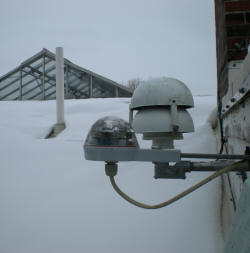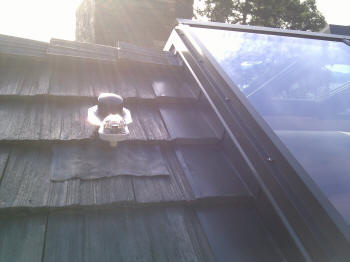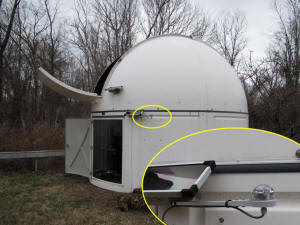Applicable Models: RG-11, RG-9
Make something happen when it first starts raining– or when it stops.
Do you have a process or device that needs to know that it is raining?
There are several Hydreon Solid State Rain Gauges that produce an output that turns on when it is raining, and off when it stops.
The sensor is extremely sensitive, and can be set to trigger on the first detected drop.
Alternatively, the sensor may be set to turn-on at a rain intensity threshold.
See the RG-9 and RG-11 instructions for details on setting the sensitivity.
Other rain sensing technologies have serious drawbacks:
- Conductive sensors do not turn off until the water evaporates, and are prone to getting stuck on due to contaminants.
- Tipping buckets are bulky and fragile.
- Irrigation-style, absorbent disks can require a lot of water to trip and stay on for days. They are also subject to maintenance issues.

 A Rain Gauge is used to control sky light windows
A Rain Gauge is used to control sky light windows
Hydreon Solid State Rain Gauges make it easy for you to incorporate rain sensing into your system.
None of the competing technologies make it easy to set an intensity threshold.
You can set the output to remain on for up to 15 minutes after the last rain has stopped, or shorter depending on the model.
Use this, for example, in order to prevent equipment from constantly turning on and off or opening and closing during changing rain conditions.
Applications
These are the perfect rain sensors for:
- Opening and closing skylights, vents, louvers, or windows.
- Process Control
- Retracting Awnings
- Enabling / Disabling equipment
 Our RG-11 rain sensor (shown in detail in inset) deployed to close an astronomical observatory at the first detected raindrop. This solar-powered application takes advantage of the RG-11 micro-power mode.
Our RG-11 rain sensor (shown in detail in inset) deployed to close an astronomical observatory at the first detected raindrop. This solar-powered application takes advantage of the RG-11 micro-power mode. 